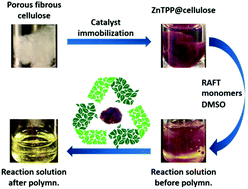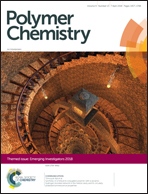A photocatalyst immobilized on fibrous and porous monolithic cellulose for heterogeneous catalysis of controlled radical polymerization†
Abstract
Natural fibrous cellulose (cotton) and household porous cellulose (sponge) as supporting monolithic materials were employed for the immobilization of a photoredox catalyst to prepare unique heterogeneous catalyst composites, which were able to effectively regulate controlled radical polymerization of diverse monomers under low energy visible light. Metalloporphyrin (e.g. zinc porphyrin), a highly efficient photocatalyst for photoinduced electron/energy transfer–reversible addition–fragmentation chain transfer (PET-RAFT) polymerization, was conjugated to the supports by effortless chemical grafting approaches. By virtue of the elasticity and robustness of cellulose monoliths, separation and recovery of the catalyst was accomplished through simply squeezing and washing with negligible catalyst leaching. The recyclability of the immobilized catalyst was comprehensively assessed, suggesting that catalytic performance had been sustained in the first three cycles. It is interesting to note that the catalytic activity of the composites after three cycles decreased due to demetallation of the zinc porphyrin during polymerization. Nevertheless, using free-base porphyrin with added co-catalyst (tertiary amine as a sacrificial agent) could prevent metal contamination of the final polymer products.

- This article is part of the themed collection: Emerging Investigators


 Please wait while we load your content...
Please wait while we load your content...